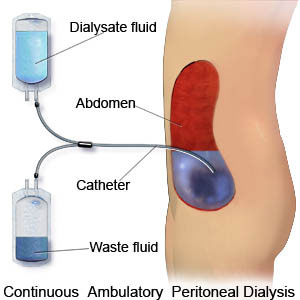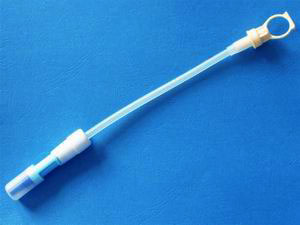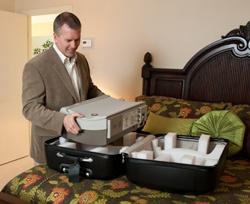Peritoneal Dialysis

Peritoneal dialysis (PD) uses the inner lining of your belly (peritoneum) as a filter to clean your blood. A surgeon will place a soft, plastic tube (PD catheter) through the wall of your belly or chest (presternal catheter). The tube is about the size of a drinking straw. Once it heals, a nurse will teach you steps to use the tube to fill your belly with sterile fluid.
Most people use a cycler for PD—a machine that will fill your belly with the fluid and empty it out. Cycler PD is most often done at night while you sleep, so your days are free. If you can do the PD steps yourself and lift the fluid bags, you don't need a partner for PD.
Once you put sterile PD fluid (dialysate) into your belly, it stays there, or dwells, for a few hours. While you go about your day, the fluid will collect wastes and water. Then you drain out the used fluid and put in fresh fluid. Draining and then filling is called an exchange. There are two ways to do PD:
- By hand
- Some people do four exchanges a day by hand. You might do one when you wake up, one at lunchtime, one at dinner time, and one at bedtime. Each takes about 20–30 minutes. This is called continuous ambulatory (walking around) PD, or CAPD.
- With a machine
-
 Most people who do PD use a cycler machine to do exchanges
at night while they sleep. With cycler PD,
your days may be free. Or, you might need to do a daytime
exchange by hand, too.
Your doctor can prescribe your
cycler to fit your life.
This is called automated PD (APD), or continuous cycling PD (CCPD).
Most people who do PD use a cycler machine to do exchanges
at night while they sleep. With cycler PD,
your days may be free. Or, you might need to do a daytime
exchange by hand, too.
Your doctor can prescribe your
cycler to fit your life.
This is called automated PD (APD), or continuous cycling PD (CCPD).
Peritoneal dialysis (PD) benefits in brief:
- Needle-free – You use a catheter for your treatments
- Portable – Take it with you
- Flexible – Choose treatment times that fit into your life
- Freedom – Eat and drink more of what you like and make fewer trips to the clinic
- Kidneys – PD keeps your remaining kidney function going longer than standard HD
Getting ready for PD

Transfer Set
Your PD catheter can be placed while you are an outpatient. You won't need to stay in the hospital overnight. Some people have little or no pain after getting a catheter; others have some pain for a few days.
TIP 1: Ask the surgeon to put a transfer set on your catheter. This is a longer piece of tubing with a valve to open and close the catheter. Having a transfer set will help you get started with PD faster.
TIP 2: Be sure your catheter won't exit your body at your beltline or under a skin fold. This will make your it more comfortable and easy to live with and keep clean.
After surgery, your PD training nurse will check your catheter, flush it with fluid, and teach you how to change the dressings until it heals (about a week or so).
Training
Once your catheter is placed, you'll have training. Your PD nurse will teach you how to:
- Set up a clean room to do exchanges
- Wash your hands
- Take care of your catheter and exit site
- Do an exchange
- Learn what kind of fluid to use and when to do an exchange
- Use your cycler (if you do APD or CCPD)
- Store and order your supplies
- Keep treatment logs
- Take your blood pressure
- Follow your diet and fluid limits
- Notice and report any problems
A PD nurse will be on call 24 hours a day if you need help.
When you first start to put PD fluid into your belly, you may feel very full—even stretched. After a week or two, you'll get used to the fluid and it won't bother you. If feeling too full is a big problem for you, ask the nurse if you can build up slowly to the right amount over a few days.
Where you can get PD
PD is the most common type of home dialysis. You can find it in all 50 states. There are more than 5,000 dialysis clinics in the U.S., and about half train people to do PD. Find a center near you.
Time

Photo courtesy of Fresenius Kidney Care
You can do PD at home, at work, or when you travel. PD exchanges take about half an hour, but you can choose when to do them. Cycler PD lets you do your treatments each night while you sleep, so your days are free. Once you're trained, you'll only have to go to the clinic once a month to check your lab tests and treatment logs. You'll also need time to check and order supplies each month, and then receive the shipment.
Space needed
A truck will bring PD supplies to your home once a month. The driver will put the boxes where you want them. You'll need to store 30 or so fluid boxes that are each about 1 by 2 feet, plus a couple of smaller boxes with other supplies. If you don't have a lot of storage space, you may be able to get half of your supplies twice a month instead. You may have to miss work to be home when the supplies come.
The boxes are heavy, since they hold bags of fluid. They have to stay dry. If you keep them in a basement, put them on shelves or a pallet—not on the floor. A closet is great, if you have one. Or, line up the boxes against a wall in a room where they are easy to reach. You can put a pretty sheet over them or a folding screen in front of them so you don't have to look at the boxes.
Care Partner tasks
In most cases, you can do PD by yourself. Even blind people can do PD with assist devices. Learn more about common PD myths. If you do have someone to help, he or she may train with you. A Care Partner can gather supplies, move boxes, set up the cycler (if you use one), or in some cases, do your exchanges.
PD may be a good choice for you if you want to:
-
Feel well all the time. PD is all day or night—not just 3 times a week. You won't feel wiped out or tired after an exchange.

Photo courtesy of Fresenius Kidney Care
- Avoid needles. PD uses no needles. Your blood does not leave your body to be cleaned.
- Eat and drink more normally. You won't have the strict limits on fluid, potassium, sodium, and phosphorus that you would have with standard in-center HD.
- Avoid missing much work time for PD training. Most clinics do PD training during work hours—but training may take only a few part-days.
- Keep your job. Fit your PD into your day or do it while you sleep. PD is work-friendly.
- Travel. You can do PD at home, at work, or while you travel. Supplies can be shipped free in the continental U.S. A cycler can go with you, even on an airplane.
- Spend more time with your loved ones. You won't need to spend much time at the dialysis clinic except for monthly visits. And, you may be more likely to think of yourself as mostly healthy.
- Protect your heart. Blood pressure is more likely to stay at a safe level when you do PD than with standard HD. PD is gentler on your heart because the treatment is slow and done every day.
- Feel in control! Research shows that the more you know about your treatment and do for yourself, the longer you may live. PD puts you in the driver's seat.
- Keep any kidney function you may have.
PD may not be as good of a choice for you if you want to:
- Swim often or take tub baths. Due to the risk of infection, your care team may want you to avoid tub baths or swimming in lakes or ponds. Some people put an ostomy bag over the catheter to keep it clean and dry for a rare swim. With a presternal catheter, you can take baths, because you can keep the catheter out of the water.
- Have days off. PD must be done each day. (Please note that having 2 days off in a row, as with standard in-center hemodialysis, is linked with a much higher risk of death.
- Keep dialysis out of your home. Since this is a home treatment, you would need to have a machine and supplies there.
- Spend time with others on dialysis. You'll go to the clinic once a month for a visit with your care team, but may not see others who use PD. You can find them online, though.
- Look slim. Having fluid—and a catheter—in your belly can affect how you look and how you feel about your body. Dialysate has sugar (dextrose) in it, which can cause some weight gain.
- Have a baby. It can be tricky to get pregnant on PD, due to the fluid in your belly. And, as a fetus grows, it takes up room that you need to get enough dialysis.
- Live as long as you can. PD survival is a bit better than that of standard in-center hemodialysis (HD). But, doing longer and/or more frequent HD—or getting a transplant—gives you the best chance at a long life.
Who is best suited for PD?
If you have had major abdominal surgeries*, you may not be able to do PD. If you are a large person, it may be hard to get enough dialysis with PD. Have a hernia? It must be fixed before you start PD. Sometimes PD can cause a hernia. If so, there is a way for you to keep doing PD while it is fixed. Apart from those health issues, the most vital factor in whether you can do PD is how much you want to do it.
*Having a baby by C-section, a kidney transplant, or a hernia fixed does not count as "major."
Thinking about PD? Learn how to choose a home dialysis clinic.

